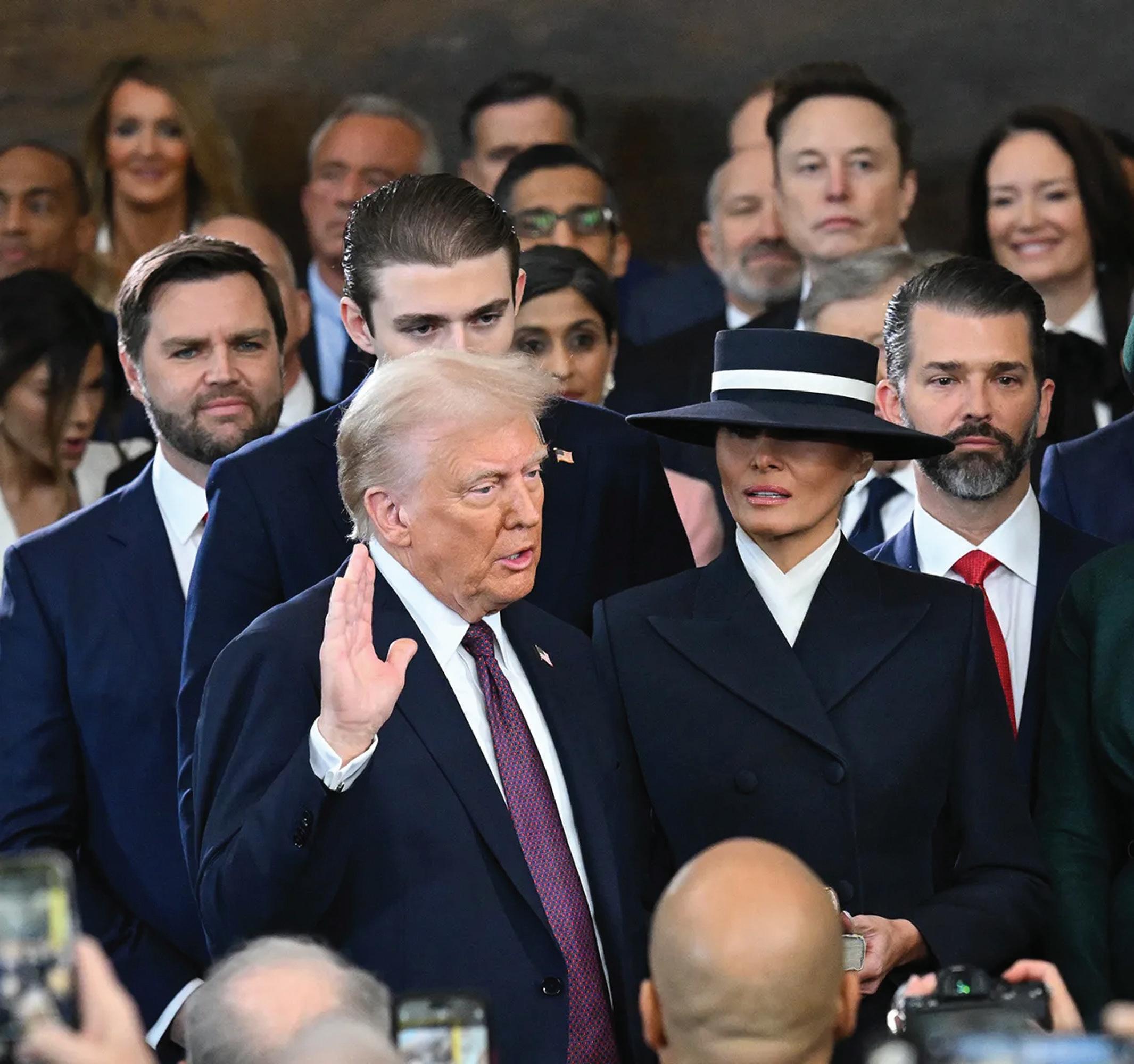

The Review
Editor’s Note
The Review is an entirely student-written, student-edited opinion magazine. We value students’ free speech heavily and strive to include work from all across the political spectrum. As we find ourselves in such a momentous time in American history, we hope you find this new edition of student opinions interesting and encourage all of you to write in the future!
- Will O’Reilly, Editor in Chief
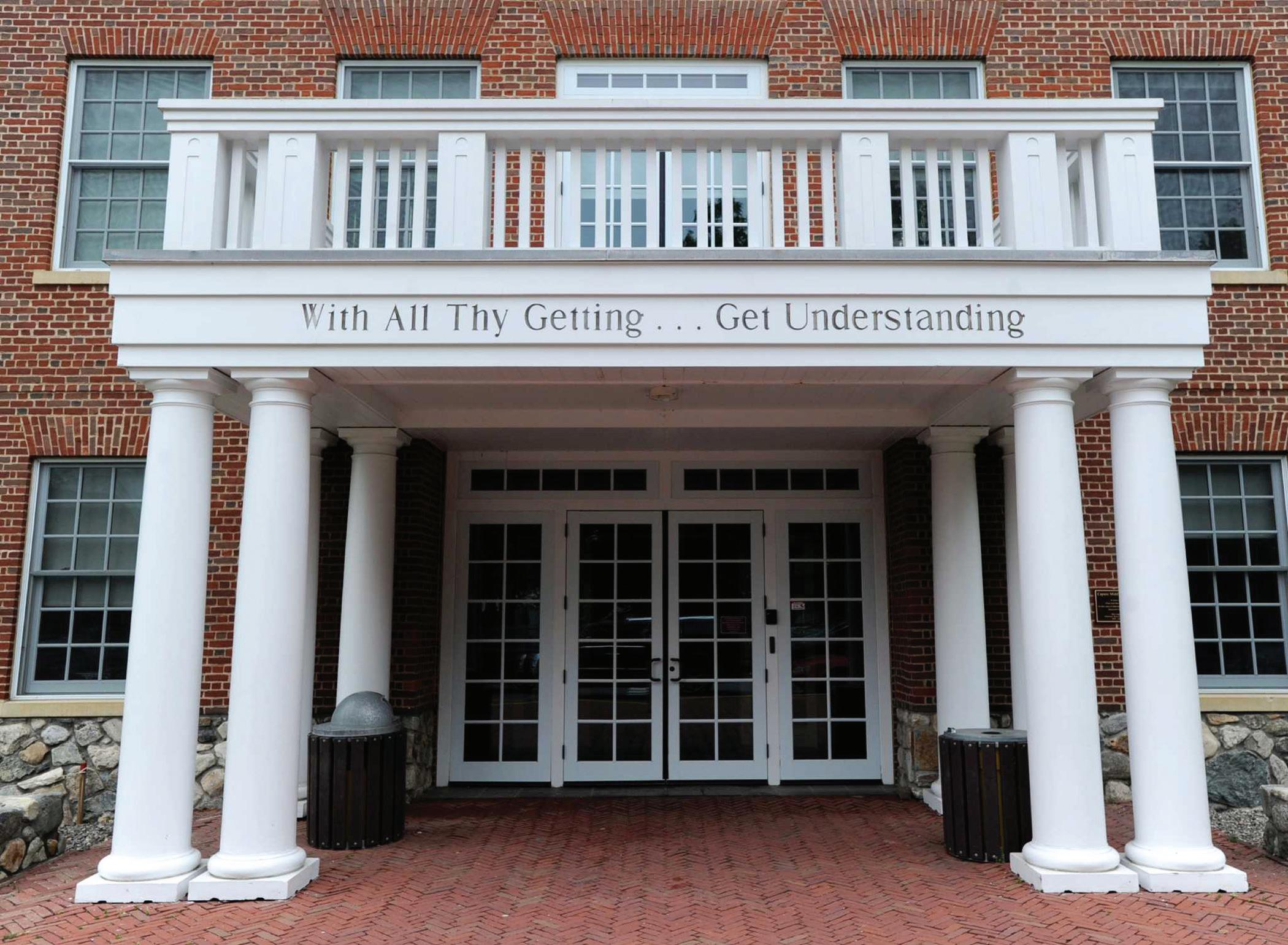
• Where Oh Where have the Dems Gone?
• Rich Feminists Take a Joyride in Space
• Liberation Day?
• Change Over Stasis
• Why We Can’t Dodge DOGE
• Looking Back at Waco
• The Toll of Tariffs 04-06 07-09 10-12 13-16 17-18 19-21 22-24
Editors
The Review Staff
Associate
Faculty
Where Oh Where Have the Dems Gone?
Will O’Reilly ’25
Ever since the results of the 2024 election, the Democratic Party has found itself in an identity crisis the likes of which has not been seen in years. If you asked what the Democrats stood for 10 years ago, the answer would be easy: they are the party of the little man, the working class, the labor unions. However, ask that question today, and the answer is far more elusive. What was once a blue-collar party in opposition to stuffy, upper-class conservatives has been flipped on its head as Donald Trump’s Republican party has claimed the working class as its own. What is left is a shell of a party that is unsure what to run on and where to turn in the future. So how did this happen and how can the Dems right the ship?
It all started when Joe Biden decided to run for a second term in 2024. Although he promised that his presidency would be merely a transitional one, he shocked the nation by running for reelection at 81 years of age. Party leadership had almost four years to find a candidate for
2024 to lead the party into the future, but instead, seemingly out of laziness or lack of due diligence, they let a nearly senile president with a plummeting approval rating be the continued face of their party. When Biden dropped out of the race, the Democrats were presented with a major opportunity once again; they could now hit the reset button and find a new candidate to distance themselves from Biden. The party should have held a mini-primary leading up to its August convention to find the best candidate with the best chance of winning. Instead, they again took the easy way out, choosing Vice President Kamala Harris as their candidate— a disastrous decision.
Harris’s failed campaign embodied everything wrong with the Democratic Party today. Throughout it, she seemed to be focused on winning votes that were already in her back pocket, rather than essential swing votes, while also relying too heavily on issues that weren’t capable of rallying the masses. In-

stead of trying to gain back middle ground voters, she operated under the false assumption that a Megan Thee Stallion concert at a rally and an appearance on the “Call Her Daddy” podcast would magically sway the average rural Ohioan. Rather than offer a concrete platform for her party, she cemented the Democrats as simply the anti-Trump party, a strategy that, unsurprisingly, proved to not be enough.
On top of this, a major complaint of voters going into the election was that Dems had become too woke and focused on identity politics. Throughout the campaign, Republicans launched ad campaigns blasting Harris for being too far left
on social issues. Once again, instead of responding to these critiques, Harris skirted hot-button issues such as affirmative action, trans rights, and DEI policies with her signature vagueness, leaving critics to assume the worst on where she stood. She also continued to avoid direct interviews, further casting a shadow of ambiguity on her stances. So how does the Democratic party solve its woes? It starts with learning from their competitors. Trump’s GOP has a clear, digestible message: build that wall and make things cheaper. Say what you want about these policies or whether they have been effective, but you have to admit that they are straightforward and easy to get people behind. The Democrats must find a similar message. Their current policies are either too elitist or too niche, and
Vice President Harris’s campaign ended in a landslide victory for Donald Trump.
The Brunswick School Review
are incapable of connecting with the very voters that Trump has stolen from them.
The second leg up that the GOP has on the Democrats is their use of social media, specifically when it comes to targeting the male demographic. In today’s America, men feel lost and think that Democrats don’t have an agenda for them. The Republican party pounced on this opportunity, putting Trump and JD Vance on popular podcasts like The Joe Rogan Experience, launching campaigns on Tik Tok to meet voters where they are, and using popular influencers such as the Nelk Boys to push their views onto young men. To put it simply, the GOP has made it cool to be Republican again if you are male, and it has worked. In 2024, White men voted 60% for Trump in 2024, and men as a whole voted 55% in his favor. For a party that prides itself on being current, the Democrats have been unable to use modern media as effectively as the GOP in order to reach voters. Out of sheer ignorance, they have let a large demographic of male voters join the MAGA movement and have devised no counter effort to win them back. If they want to come back with a vengeance during the next election cycle, Dems need to

rethink their social media strategy and directly target the crucial male vote.
The next four years will be crucial in the reinvention of the Democratic Party. As the GOP moves further to the right, Dems have an opportunity to promote more moderate candidates and drift away from their overly woke agenda that lost them the 2024 election. They cannot just be the party of DEI or of LGBTQ rights; for better or worse, we have seen that this is not a winning platform. They must find fresh talent, prioritize large-scale issues, and improve their media outreach to adapt and survive in our current political climate. Failure to do so will lead to a continued reign of MAGA Republicanism for years to come and the continued disempowerment of the Democratic Party.
Trump appeared on the popular “This Past Weekend” podcast with Theo Von.
Rich Feminists Take a joyride in Space
Gianna DeBono ’25
In 1963, Soviet cosmonaut Valentina Tereshkova’s solo space flight marked the very first all female flight crew; Sixty-two years later, in the greatest achievement of modern space travel, Jeff Bezos launched his girlfriend and her friends into space in a blaze of feminist glory. Both events involved a journey beyond Earth’s atmosphere, but only one brought Oprah Winfrey to tears, and it wasn’t the Soviet astronaut. The recent liftoff of Jeff Bezos’ crew of celebrity astronauts aboard the Blue Origin (although to dub any of the crew an “astronaut” is certainly amusing) has not only brought Winfrey to tears, but has incited media excitement which might rival that of Tereshkova’s mission. Blue Origin’s NS-31 Mission launched into space at 9:30 a.m. ET on April 14th, 2025, carrying its six passengers past the Kármán line, the internationally recognized boundary separating Earth’s atmosphere from outer space, before returning to Earth in the span of 11 minutes. The event

has since, and controversially, been dubbed “historic” and “groundbreaking” by such outlets as CBS News and Vanity Fair, who celebrated the brief field trip into space as a pinnacle of female empowerment. The girl group who inspired such dramatic praise consisted of none other than pop star Katy Perry, “CBS” Mornings” co-host (and Oprah’s best friend) Gayle King, and Bezos’ fiancée, Lauren Sánchez, along with civil rights activist Amanda Nguyễn, film producer Kerianne Flynn, and former NASA rocket scientist Aisha Bowe. The group was Sánchez’s brainchild, an idea born following Bezos’ own trip
Perry and a crew of five other women were launched into space April 14th.
to space, after which he asked if she might one day want to “go up,” to which Sánchez responded “Could I take all women up?”
And she certainly did, making it an especially fortunate day to be friends with the fiancée of a billionaire. The six lucky women underwent a total of fourteen hours of training over the span of two days to prepare for their cosmic rendezvous, the culmination of which involved Katy Perry serenading her fellow passengers in Zero-G. In her interview upon landing, Perry commented that she felt “really connected to that strong, divine feminine”, and that she was “really feeling the love for [herself]”. And while Perry neglected to define exactly what the “divine feminine” is, at least we can be certain she isn’t lacking in selfinterest. In the subsequent days, the mission received a fair amount of backlash for its high cost and extravagance. Gayle King responded to critics who have been referring to the mission as a “ride” in her complaint that “you never see . . a male astronaut who’s going up in space and they say ‘he took a ride’”. Gayle is absolutely correct. In fact, she forgot to mention that no one ever tells female astronauts that they simply “took a ride” either, because a space mission is different than a

Perry dramatically kissed the earth on return.
joyride.
The fundamental issue with King’s response lies in the fact that, other than Katy Perry stooping to kiss the ground like a soldier returned from war, nothing revolutionary actually took place on April 14th aboard the Blue Origin, and the insistence that it did is a mockery of true astronauts. In fact, nothing of exceptional importance happened at all. King goes on to explain that the Blue Origin mission followed the original 1961 flight pattern of Alan Shepard, the second person and first American to travel into space, as justification for the mission’s praise. The only difference, however, is that Shepherd was, indeed, the first American, and an astronaut who trained for years before his first spaceflight, rather than an extravagantly wealthy space tourist. The process of astronaut selection and candidacy is years long, and has such requirements as ex-
pertise in the STEM fields, peak physical condition, and at least 1,000 hours of pilot-in-command time on aircraft, among others. The 14 hours of training undergone by Sánchez and her friends is less than the 30 hours of classroom time required for a driver’s license in the state of Connecticut, and the DMV certainly didn’t declare my completion of Drivers’ Ed a “historic feminist moment”. The spacecraft was completely autonomous, requiring little from its “crew” other than the capacity to fasten and remove a seatbelt. Even with that singular task, Lauren Sánchez and her menagerie of women had far less responsibility for the craft than the average airplane crew. Not only is their status as astronauts highly questionable, but these women conveniently forget Valentina Tereshkova, who, as mentioned priorly, was the Soviet cosmonaut who constituted the true first all-female crew (and it’s difficult to believe that their memory slip is in the interest of American patriotism).
Lauding the event as anything more than space tourism for the uber wealthy belittles the accomplishments of the 61 female astronauts NASA has selected since its inception, and the true pioneering accomplishments of space-faring
men and women alike. At 28 million dollars a seat, a ride on the Blue Origin instead boasts the very same elitist privilege and access that women of their political leanings criticize so adamantly. Yet, according to Gayle King, the mission is an important example of what “women and young girls can do”. If the example Gayle is speaking of is dating an exorbitantly rich man, I certainly agree.
King’s words highlight the glaring message to be gleaned from this event: modern feminism desperately continues to attempt to break nonexistent barriers in America. It ignores true merit and achievement and instead advances the harmful message to young girls that they live in an inherently sexist society. The Blue Origin mission is an example of the perpetuation of frivolous identity politics and so-called “female empowerment”. Those involved chose to advance the tired narrative that women are subjugated in modern American society, rather than taking an opportunity to point to the genuine achievements of generations of NASA astronauts, both male and female, and celebrate their intellect and courage rather than their ability to fill a diversity quota.
Liberation Day?
Neel Behringer ’26
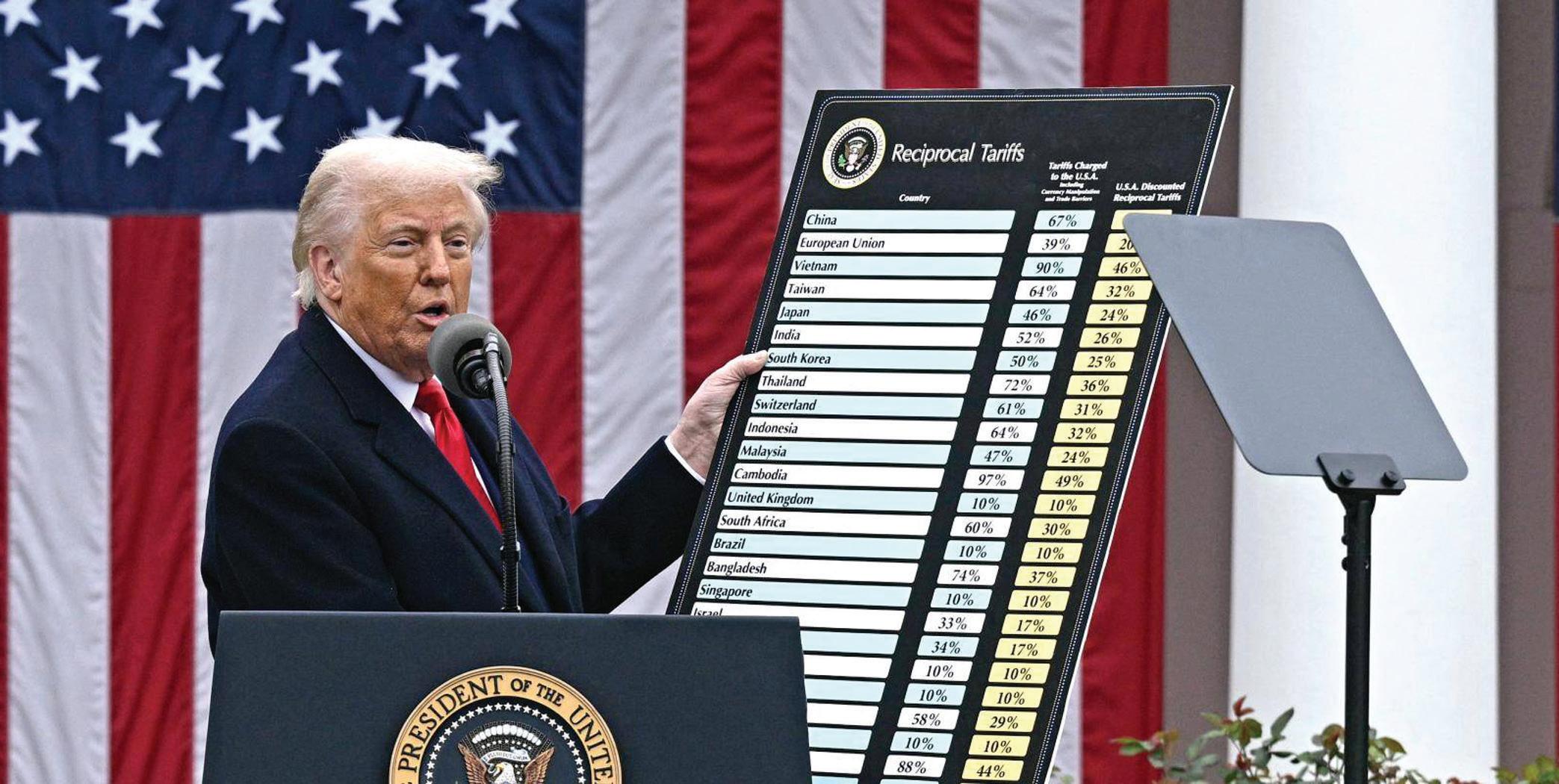
On April 2nd, Trump announced a slew of tariffs in the White House rose garden.
Over the past four months, the Trump administration has executed a flurry of executive orders ranging from immigration policies to geopolitical toponyms to government efficiency. However, its most controversial action occurred on April 2, Liberation Day. Despite its harsh criticism, the tariff gamble will work if Trump uses it as a negotiation tactic to augment America’s status in the world.
Trump has claimed that America is being “ripped off” via trade deals, deficits, and policies from almost all of its trading partners. The current secretary-treasury, Scott Bessent, argues that opening up the American economy to geopolitical
rivals at the beginning of American globalization in the 1990s has had unintended consequences. This, in turn, has created vulnerabilities: the increase in Chinese prosperity has altered the balance of power of the political-economic state of the world. In addition, the Trump administration also protests that America is being used to finance major supranational organizations, such as NATO, for little gain. Finally, the massive trading tariff-based deficits the US has with almost all of its trading partners— allies or not— are another way America is being “ripped off,” according to Trump. He sees the $918 billion lost each year due to these deficits as a source
for improvement.
Trump’s haphazard plan involves tariffs. As of this writing, we are still in the ninety-day pause from April 9. During this time, he plans to negotiate with other countries regarding these tariffs. If he wants to achieve these goals, this is how he should do it.
First, he needs to move manufacturing away from China. The 135% tariff—and the current tariff war with China—are already helping. China’s economy is productiondependent. When major American corporations pull their manufacturing out of China, over time, the country’s economy will shrink (especially its GDP). For example, seventy percent of Amazon products come from China. =Suppose Amazon were to move its dependence from China and find a new country to produce/manufacture goods. In that case, the Chinese economy will take a substantial hit while Amazon maintains its overall revenue. However, it is not just for Amazon; it is all American corporations, too. The greatest threat to the Chinese economy is the incentive for American corporations to shift their manufacturing.
This step is not impossible
either. Apple has already begun moving its manufacturing to India. Furthermore, it plans to produce at least 50 million iPhones and aims to manufacture all US-bound iPhones in India by the end of 2026. Apple proves that major American companies are willing to shift manufacturing in response to the massive Chinese tariffs. This leads to step two of the gamble: free-trade agreements. To further incentivize the shift in American manufacturing and less dependence on the Chinese supply chain, Trump has to negotiate freetrade agreements (FTAs). Trump and his staff - along with many (or every economists - acknowledge

that these massive tariffs are unsustainable and will not help in the long run. Yet, they also know that the tariffs are not only hurting America. He knows that America’s trading partners do not appreciate them, which explains why countries such as the Apple moves iPhone production to India.
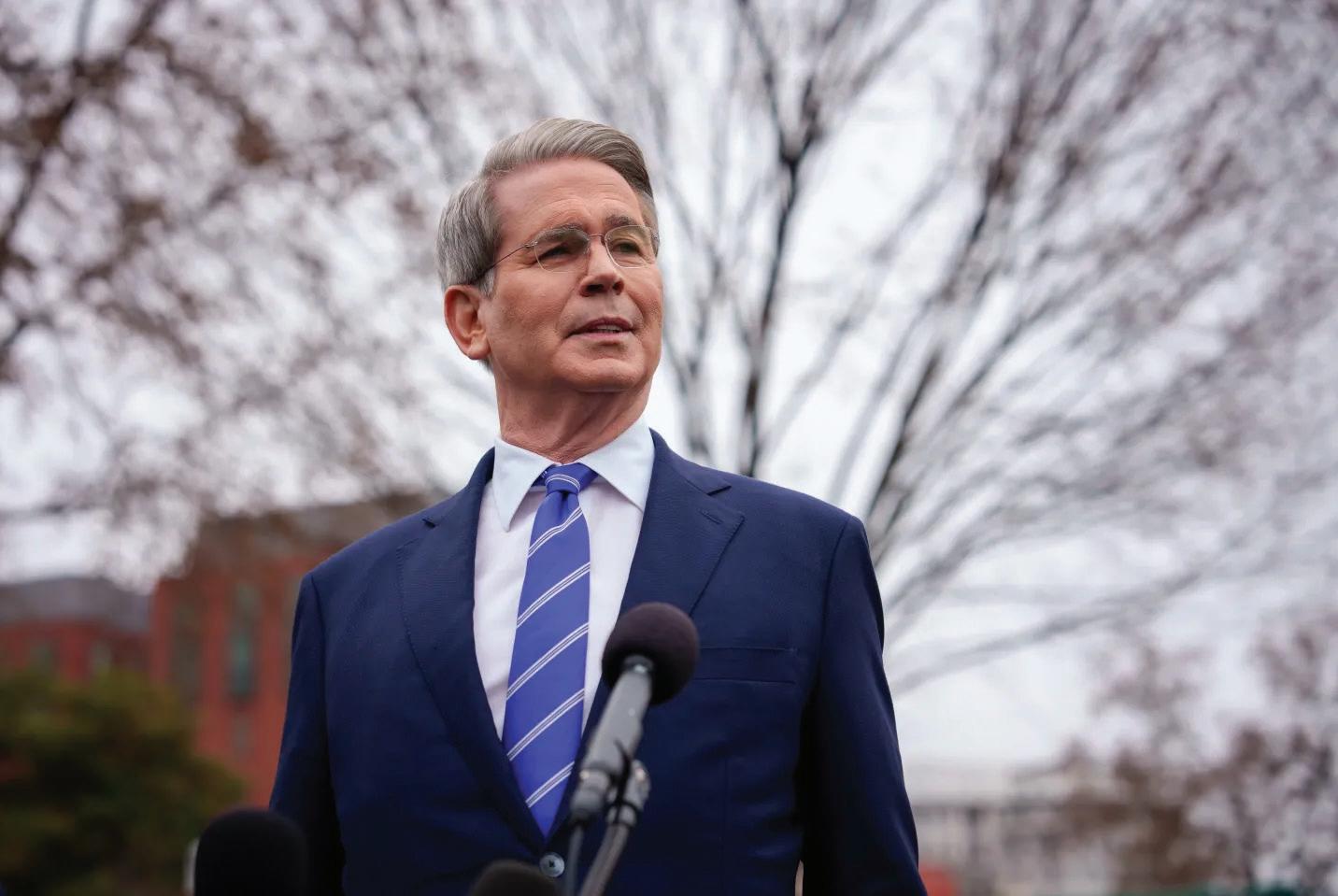
Treasury secretary Scott Bessent has been a strong advocate for tariffs.
Philippines and India were quick to remove their tariffs. So, during this ninety-day pause, Trump should be working on a deal to lower both the American tariff and the European/ Asian tariff to a free trade agreement (FTA). The US saw great success with FTAs with NAFTA, and if they were applied to the global economic web, then there would be even greater economic potential. In addition, American corporations would then also shift their manufacturing to these countries because they are also manufacturing countries. Countries such as Germany, Japan, Korea, and the Philippines would all accept more American outsourcing to improve their local economies and their GDP. Moreover, the new tax bill that is making its way through Congress would also help subsidize these manufacturing sectors, according to Bessent. Trump wants manufacturing to shift back to America, however, the cost of production here is too high, so it is
not feasible. However, if manufacturing is shifted to anywhere but China (ie, American political allies), then the cost to produce goods will stay the same, the cost of transportation will remain the same, and the consumer will pay less because of the FTA.
Of course, this plan to transition the manufacturing areas of the world will take time, and the US economy will take a hit. But the US economy is resilient, and once the transition is complete, it will recover as American demand will remain constant over this period. If Trump successfully negotiates FTAs, then the money lost to trade deficits will decline, China will reduce its exports because American manufacturing will leave, and American consumers will pay lower prices for foreign products because the tariffs on both sides are gone.
Overall, the tariffs are unsustainable and should only be used to catalyze negotiations. If Trump does want to re-establish the world order, he should use these tariffs to shift manufacturing to American allies and establish a web of free trade agreements to maintain American consumer spending. This gamble has never been about short-term victories; rather long-term American dominance over the world economy.
Change Over Stasis
Dylan Arouh ’26
As forces hostile to the constitutional system test its stability, it is vital to look beyond the understandable hope that the ex-ante order can simply be restored and form, in the depths of the present crisis, an affirmative vision for the future. Herein is an attempt at empowering the introduction of one. This project begins with a counter to the reluctance of the great majority to countenance dramatic constitutional change, before laying out the case for the renovation of the institutions of American democracy, and then proceeds to outline the broad contours which reform might take. Ultimately, only through the honest acknowledgment of the Constitution’s obsolescence, and the imaginative pursuit of structural reform, can liberal democracy in America be preserved and revitalized.
In justifying the argument in favor of substantial change, a review of history will be quite helpful. Of first note is the fact that the Framers themselves thought continual renewal was important, even inevitable—why else would they
have included the amendment procedure? Perhaps it was a small act of humility. Such intellectual modesty would be fitting, considering that the compromise struck for an agrarian state with a population of four million people, seven-hundred thousand of them slaves, was never built to withstand the demands of a continental, industrial superpower.
To even speak of the “Framers” as some sort of uniform group speaking with one voice is quite silly. They disagreed, often, and most found the document disappointing in some way or another. Its first ten appendages, the Bill of Rights, were not intended to be a part of it, but were rather only added after the fact to secure ratification. The next seventeen were a mix of course corrections and questionable experiments—no, no, slavery really should be illegal. Women should be able to vote. We also tried banning alcohol. The very words of the Constitution have been “reinterpreted” to accommodate governance under a, for all intents and purposes, different constitution. Hamilton, a Fram-
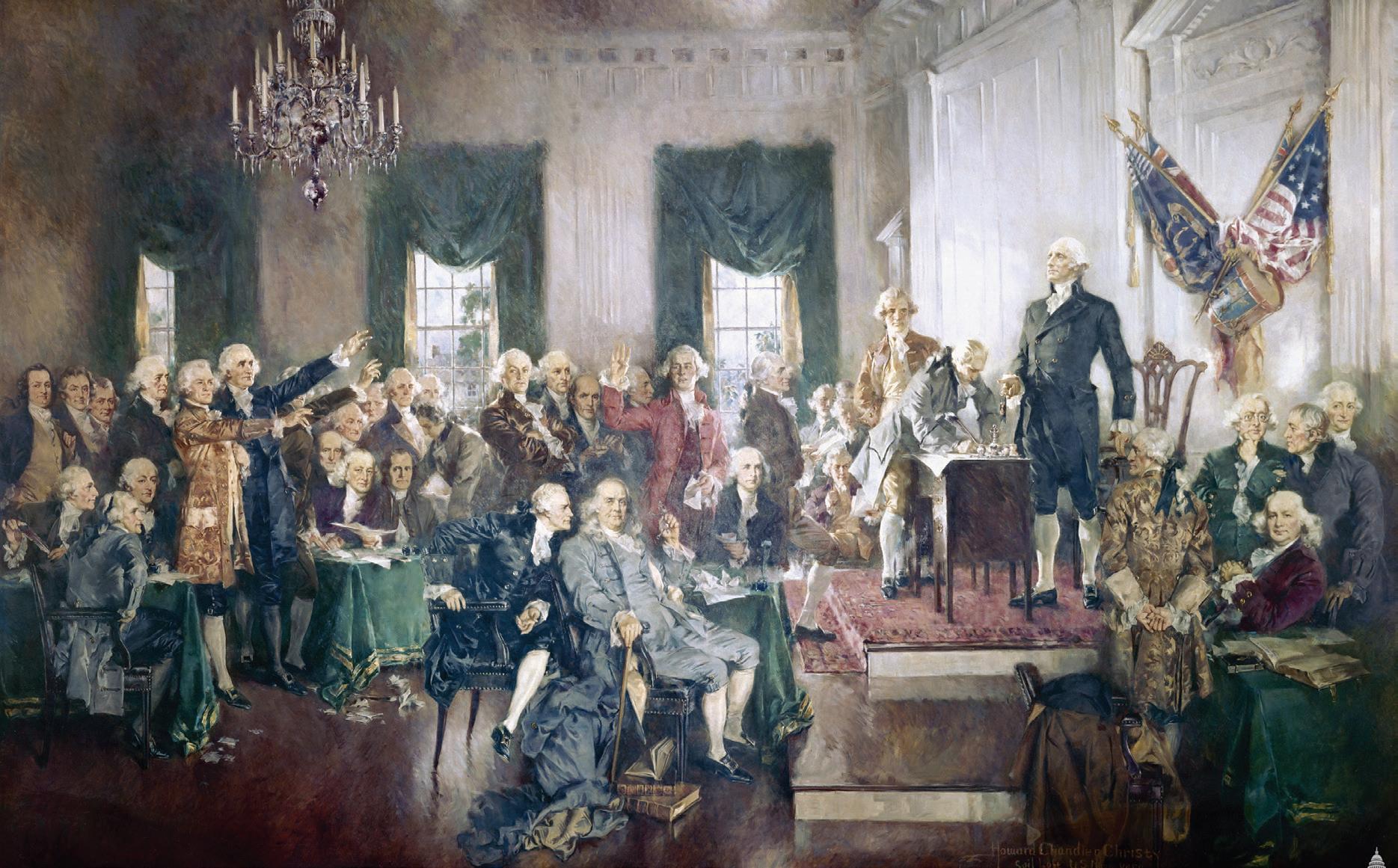
er himself, interpreted the Necessary and Proper clause as sufficient to expand the federal government beyond the enumerated powers and into the establishment of a national bank, prompting Jefferson to express his fury in anonymous polemics (mind you, this was three years after the Convention). There are modern examples, too: Justice Blackmun, in Roe v. Wade, found in the “penumbra” of the Constitution a heretofore hidden right to abortion. Much reinterpretation has amounted to de facto amendment.
Let me be clear, though: change is good. Our Constitution has continually evolved since the founding because the interests of the citizenry compelled it to. This is something that even President
Washington reportedly acknowledged, as a Georgia delegate said that he remarked at the Convention that the document would not last more than two decades. The purpose of the preceding is simply to dispel the notion that the Constitution is some cast-in-amber-worthy piece of genius—not least because for most of history, it was not cast in amber!
It has been recently, though. The amendment process has effectively ground to a halt; the last one was adopted in 1992, and even then, only via a gimmick too complex to explain here. Why has the Constitution not been improved upon in the last thirty-five years? Many reasons. One of the principals being that the current order allows a rural mi-
The 1789 Constitutional Convention had its fair share of debate.
nority undue power over the country via the Electoral College and the Senate. This minority, which is out of step with the dynamic, economically productive and culturally dominant urban centers found on each of the coasts, is reluctant to approve the death of its political power. That is, if each citizen were to have equal political power, political dynamics would shift markedly, and not in a manner favorable for the rural faction. Of course, in moving through this analysis, it must be remembered that the rigid text of the Constitution is not the north star of politics, and that the values of liberal democracy are. The problem is that the former has qualities injurious to the latter.
Yet even if the constitution currently in place did not fully embody the values of liberal democracy, one could still wish it would produce a functioning system. Unfortunately, the order produced by the archaic document is, as virtually every American is happy to admit, dysfunctional. The last Congress, the 118th, was the least productive in modern history. For eight of the years since 2000, the country has been ruled by a president who did not win a majority of the vote. As alluded to earlier, policy questions
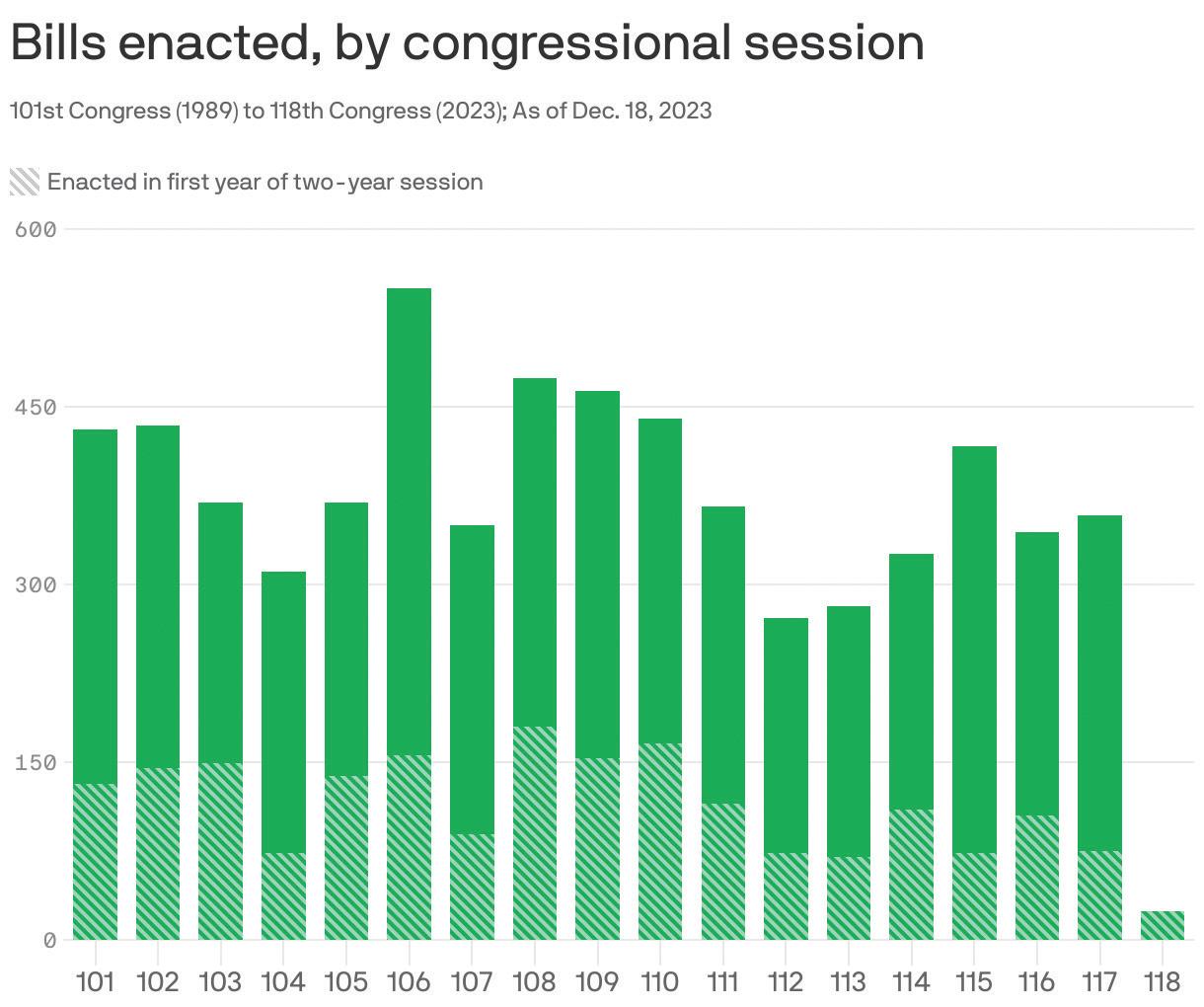
By the end of 2023, the 118th congress was historically unproductive.
are increasingly being decided by the Supreme Court. The Executive branch is home to a vast administrative apparatus, which occupies a sort of grey area. The branches have been warped beyond anything the framers would recognize: a turgid Executive, a feckless Legislative, and intermittently legislative Judicial. This is a confused system. It is one which would not be produced if proceeding from any set of first principles but is defended on the basis of an at best tenuous connection to an at best nebulous grouping of “Framers.” I am not suggesting that a return to the constitutional system of the early Republic era—or any other one, for that matter—is called for. It isn’t. But neither is the current iteration of the republic. As the need for a reforming mission has become apparent— consider it the buildup of deferred maintenance—the rate of amend-
ment has, as discussed, slowed and a near-taboo surrounding constitutional critique has taken hold. A woefully imperfect document is now sacralized. In one sense, I sympathize with those that firmly grasp the existing constitutional system. It is the quite understandable response of political sects wishing to preserve the status quo, lest the institutions they be subjected to take the shape of another, extremist, faction’s design. It’s not acceptable, though. Without an ambition beyond the reflexive defense of a faltering order against even worse alternatives, all defenders of liberal democracy can hope to secure is the maintenance of the current.
To truly serve the democratic ideal, its purported defenders ought to acknowledge that (1) the current system has deficiencies (2) which were produced in no small part by the logical lacunae of the Constitution and (3) new constitutionalizing should commence, to reform and not destroy the system produced thus far.
But once such an acknowledgement is made, the paths open up. Imagine! An America which has regained its political imagination, free to set about on a path towards a more dynamic system. Could the
current notion of states be reconsidered, with new regional groupings or city-state methods of organization? How may the necessarily bureaucratic nature of much (post-) industrial governance be brought into better harmony with democratic principles? Because the scale of the problem and solution to be acknowledged was so great, and yet lies so far outside the Overton window, the lion’s share of this article has been dedicated to its discussion. Left for others are the answers to the questions implied or outright stated.
For now, simply defining the scope of the problem is sufficient. Our current civic dysfunction, born of a failure to reform the Constitution, has bred distrust in our ability to build a more perfect Union, and given rise to a wish to settle for the current one. Our much-talkedabout commitment to that Union, though, compels us to cure our government of its stupor, take the leap, and strive for change over stasis.
Why We Can’t Dodge DOGE
Alex Pombo ’26
Elon Musk exceeded all expectations on how much influence he would have over the White House and the bureaucracy when he immediately got to work dismantling USAID within the first few weeks of the Trump Administration. He has continued to be arguably the most influential Trump advisor, setting his sights on the Department of Education, the FBI, Social Security, the CIA and any other department or program he deems to be running inefficiently. All of this begs the questions, are all the DOGE actions necessary, and is Musk qualified to be the one who oversees it all?
The short answer is yes. The government has long been bloated with unnecessary and wasteful programs, but nobody has had the initiative to tackle the problem of “draining the swamp” for years. That is, until Musk took matters into his own hands, starting with his interview with Trump this August. The idea of “draining the swamp” has existed long before any Brunswick

boy, or even some of our teachers were born, yet Musk has really been the first person to meaningfully act on it. Moreover, Musk is uniquely qualified to lead the charge, running multiple billion dollar companies efficiently enough to make him the richest man in the world. If his companies were wasting the amount of money that the federal government does, he would be nowhere near as successful as he is today.
But why is government bloat so hard to cut? Well for starters, our congressmen would rather sit and watch all our problems get worse instead of actually carrying out their duty of congressional oversight. On top of that, department heads have
Musk’s DOGE “took a chainsaw” to America’s bureaucracy.
no interest in slicing up their own departments, as that would merely be an assault on their own power. Take Kash Patel as an example; Patel was chosen by Trump to lead the FBI because he was loyal and he promised to dismantle the department from within because of how it was weaponized. Yet, Kash Patel has not done anything to reduce the size or power of his department, instead seeking to replace its partisanship with one that favors the new administration. We have not even seen a plan for the complete restructuring of the department that Patel originally promised. He has no interest in tearing the FBI down to rebuild it from scratch, but Musk does. In fact, when Musk took matters into his own hands and sent an email to all federal employees asking them what exactly they get paid to do every day, Patel instructed FBI agents not to respond.
That is why we need Musk. Without him, the job simply would not get done. We saw a similar situation play out with Marco Rubio as Musk went after the State Department, but this time the argument happened in front of the president. Trump sided with Rubio, probably fearing a second episode of the constant feuds in his first admin-
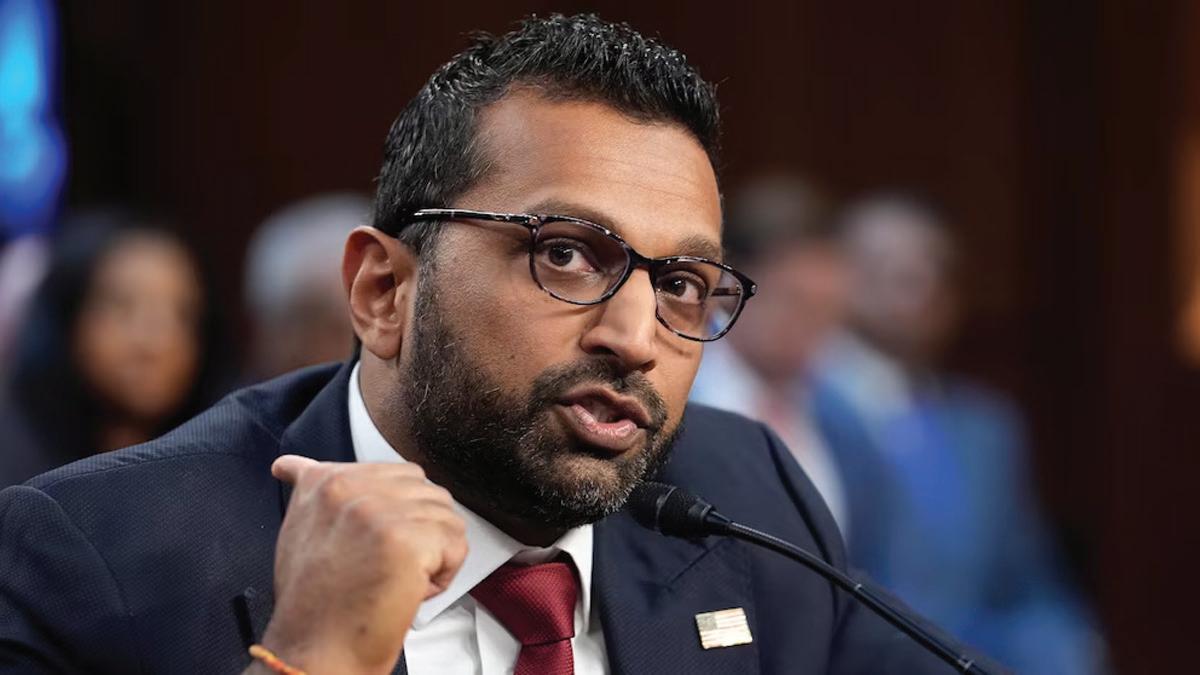
istration resulting in scandal after scandal. This decision however, essentially removed Musk’s ability to bypass Cabinet members by using his influence over Trump. Now, we are back at square one, where no department head will do the right thing and allow for their department to be changed.
Musk and his DOGE have provided an incredible opportunity to finally audit and change wasteful spending within the bureaucracy, all funded using his own money. Yet, the greed and selfishness of department heads continues to prevail and an end to the endless bloat of the executive branch seems like it will never come. Denying Musk the ability to act in all our best interests and remove waste within the federal bureaucracy will prove to be a mistake that will haunt us for years to come.
FBI director Kash Patel has been reluctant to reduce the size on his department.
Waco: A Tale of Governmental Overreach
Chris Errico ’26

On a dry spring morning in Waco, Texas in 1993, tanks supplied by the department of defense had their barrels pointed at a rectangular compound housing men, women, and children of the Branch Davidian Cult. Live on national television, government forces attacked the compound, causing a fire and the death of over 80 Americans, 25 being children. What initially began as a flimsy Department of Alcohol, Tobacco and Firearms (ATF) investigation turned into a government bloodbath and a clear violation of the U.S Constitution. The story of
Waco sparked large-scale distrust in the government, raising questions about the balance between law enforcement and civil liberty. America in the 1990s was characterized by the emergence of spiritual exploration coupled with millennialism and religious radicalism. Charismatic and self proclaimed divine, David Koresh, a young man from Houston, gained power over the Branch Davidian sect at Mount Carmel in Waco. Koresh’s personality and ability to galvanize the group allowed him to exert absolute control over his sup-
The Branch Dividian compound in Waco, Texas
porters. Keresh’s practices included polygamy with underage girls to create a so-called “House of David” bloodline which would pass on his legacy. Koresh became the main aspect of many of his supporters’ lives, who believed he was a messiah and was to be worshipped and venerated. Believing that a “final battle” was coming in an apocalyptic style jihad, Koresh acquired automatic rifles to arm his people, gaining the attention of the ATF. Believed to be illegally modifying weapons, the ATF launched a raid on the Mount Carmel compound. In the ensuing 51 day-long standoff between the Branch Davidians and the US government, four U.S agents were killed and many others wounded.
Koresh’s beliefs of an apocalyptic end were coming to fruition. Government tactics included blaring loud sounds into the compound and using powerful searchlights to deprive the Dividians of sleep at night. FBI tactical teams later joined the scene, equipped with tanks and other armoured vehicles fresh off fighting in Iraq. Many of Koresh’s supporters, including himself, believed that they were ordained by God to die in a final solution causing a sense of divine annihilation to spread amongst the group. Fearful of another Jonestown, in which

thousands of Americans committed suicide at the hands of the cult leader Tim Jones, the FBI eventually believed that negotiations were futile and they had to conduct an assault. Attempting to “gas” the Dividians out, tanks dropped in military grade teargas. The teargas caused a large fire which engulfed the compound. To make matters worse, the FBI blocked many exits causing the Dividians to be trapped inside the building. Whether caused by smoke asphyxiation, incineration, or the ultimate collapse of the compound, the Branch Dividians were largely wiped out.
Who was to blame for the death of so many Americans at the hands of the government? Was the operation botched or were the Branch Davidians hoping to achieve a martyred death? Whatever the case may be, the flagrant overstep of governmental forces against civilians was
David Keresh was believed to be a messiah by his followers.

clearly unconstitutional. The Posse Comitatus Act, signed in the infant years of the country, banned military personnel from conducting any operation against U.S. civilians. Although army personnel did not participate in the ultimate siege, military equipment and tactics were used against citizens. Furthermore the barbaric tactics of the FBI violated the fourth amendment in the use of over-excessive force. The initial ATF investigation that started the entire fiasco also brought into question the legality of investigating a religious institution. Under the first amendment, Americans are permitted to practice whatever religion they want in any capacity. Infiltrating a religious group on loose suspicion of arms violations threaded the line of governmental overreach.
Unfortunately governmental overstep was not isolated to just Waco. A year prior, ATF agents
in military ghillie suits assaulted Randy Weaver’s home in rural Ruby Ridge, Idaho due to suspicion of illegal modifications of shotguns. A former Green Beret and veteran of Vietnam, Weaver became paranoid and refused to surrender. The resulting standoff which was televised on national television yet again concluded with FBI snipers shooting his fourteen year old son and wife while she was holding her ten month old baby. The stories of Waco and Ruby Ridge highlighted the need for change. Both tragedies, which were caused by futile charges resulted in immense death and public outcry. In an attempt to control gun violence, governmental authorities ironically precipitated the opposite outcome.
As Americans, we must work to reaffirm our constitutional liberties. Governmental organizations like the ATF, which is unnecessary due to local investigators and the FBI should be disbanded. Although the tragedy at Waco was precipitated by apparent illegal activity, the overall process and result of the situation demonstrated a gross violation of religious liberty and protection from unnecessary force: two values we must continue to fight for in an ever changing society.
The compound was left in flames after the government raid.
The Toll of Tariffs
Henry Wise ’26
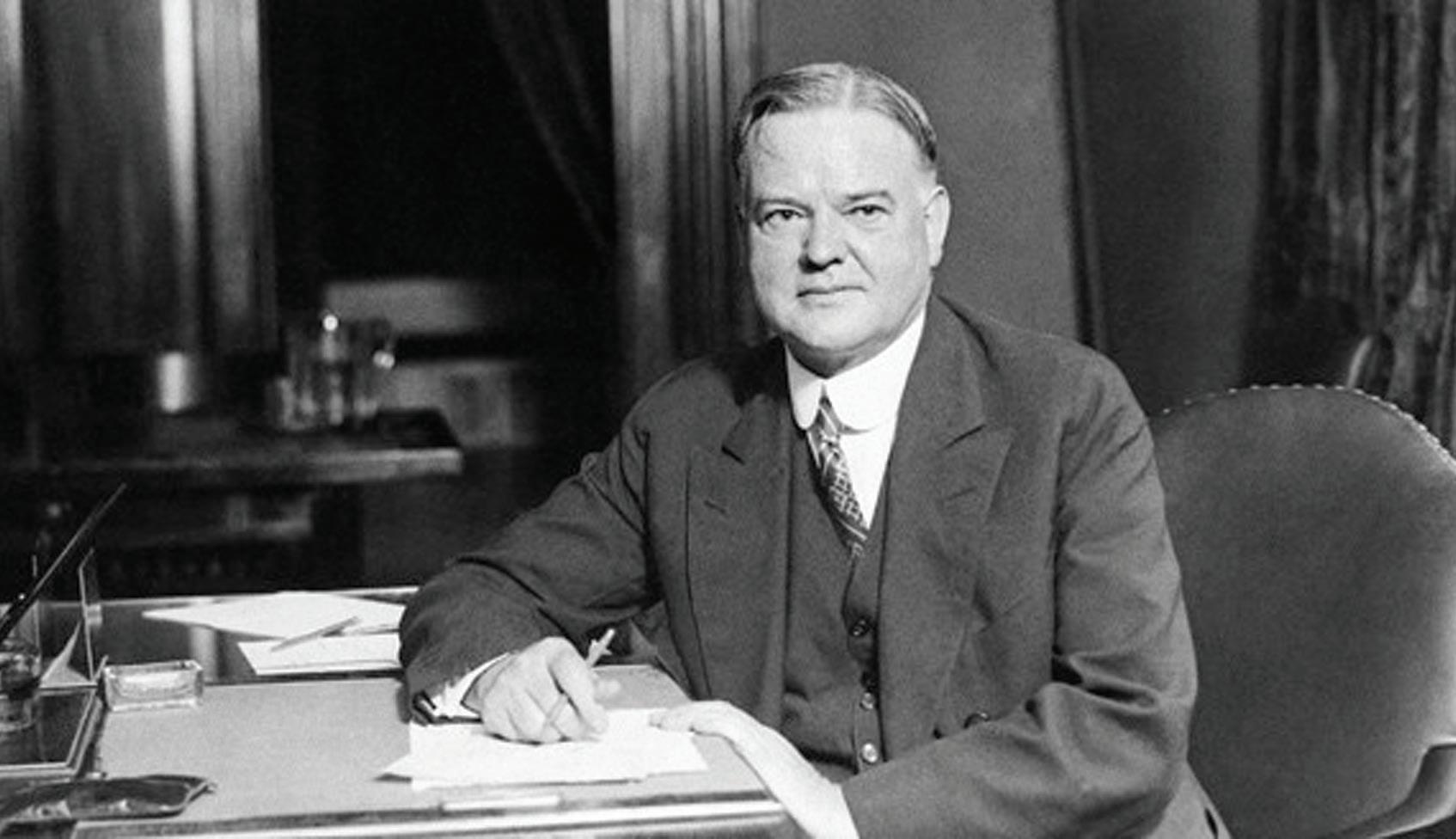
The tariffs are reminiscent of President Hoover’s
Prosperity promised and markets plummeting; what is to follow? The current drama of tariffs can best be contextualized by understanding the history of American tariffs and foreign economic relations. In 1789, the young United States made an essential revision to its original Articles of Confederation, permitting the federal government to impose tariffs on foreign markets by means deemed necessary. This change would have significant implications on the course of American history, as seen in pivotal events that followed.
Between 1861 and 1933, the United States held the title for high-
est tariffs on manufactured goods in the world. Reigning through a seventy-plus-year time period, the U.S. raised tremendous revenue and created barriers of trade which fortified one of the world’s strongest economies. Towards the end of this stretch, in 1930, the United States had its greatest financial crisis of all time, one cause of which was the Smoot-Hawley Tariff, a protectionist tax on imported goods. As a result of the tariff, markets cascaded into what became the infamous Great Depression where millions of Americans and American institutions were left financially fractured. Fast forward to 1991, with the closure
Smoot-Hawley tariffs of 1930.
of the long-drawn Cold War, the U.S stood as arguably the world’s only remaining superpower both politically and economically. Yet, in 2025, things are looking shakier than they have since the late 2000s.
In early April of 2025, President Trump is transforming American tariffs and foreign economic relationships, while still just months into his second term. The U.S. government’s website states that “President Trump is invoking his authority under the International Emergency Economic Powers Act of 1977.” Using this act, President Trump instituted a 10 percent minimum tariff on all countries, and a tariff rate of up to approximately 145% on China. These tariffs are seen by many Americans, political affiliation aside, as unprecedented and unfair as they contort the value of American stock and dollar and raise a myriad of other issues. The purpose of the tariffs, as outlined by the Trump Administration, was primarily to close the gap between U.S. imports and exports in relation to its largest economic competitors who in some cases are also key partners. In support of the claim that closing this gap is necessary, U.S. manufacturing has declined roughly 10 per-
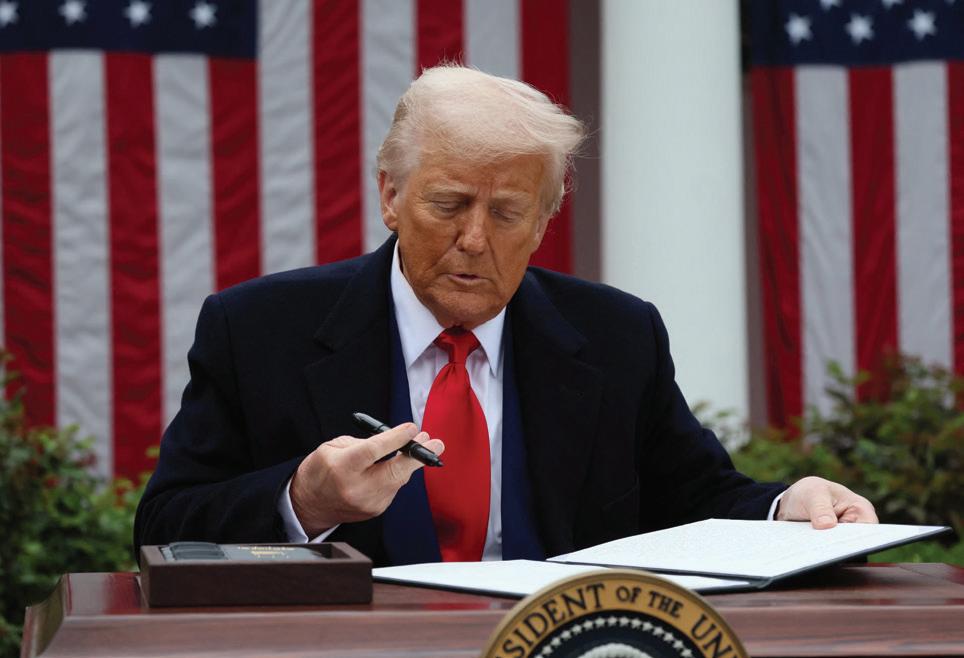
Trump has used the IEEPA to justify his tariffs.
cent since 2001, therefore this may be a reasonable goal for the U.S. to pursue.
Nevertheless, the reactionary statistics to the new tariffs as of April 11th aren’t looking very hopeful in the short-term. Current statistics are as follows: the value of gold is down 2 percent; the S&P 500 closed 1.6 percent of its entire market share; crude oil value is down 12 percent; the British Pound Sterling, Euro, and Russian Rouble are all fluctuating more than they have in recent years. Will things get better? Analysts at top firms like JP Morgan and Morgan Stanley have publicly stated that they predict a 40-50% chance of recession in the following months given the numbers produced by the tariffs impact. For this trend to mark a depression, the U.S. economy would need to undergo two continuous negative-output
quarters in the market, which would take approximately six months of a standard calendar year. Albeit, time will only tell if a bad quarter will drag out, or even two consecutive bad quarters. In the meantime, Americans from all backgrounds are left to speculate.
In the short-term, tariffs may often help promote the stock of a certain industry and force a competitor to lower their grip on a market by adjusting their tariffs and prices appropriately. Yet, as seen in this instance with President Trump’s tariffs, countries are responding more negatively. Many, like China, are refusing to bend the knee, and are clapping back equally or even harder in response. The argument of whether these tariffs are just or will succeed is not one to be determined on the basis of political bias. This is neither a Republican nor Democratic position to take but rather an economical conversation to be had.
With consumers swamped in higher prices on shipped items manufactured from countries like China, Bangladesh, and Canada, the question of where will the economy go next is a burning one. In its first week, the tariffs implemented by the U.S. government have only disrupted supply chains and yielded
retaliatory tariffs which have come at a greater cost than any countries submitting to U.S. economic authority. Moving forward with such precedent on tariffs may have long-term implications on trade policy which could be more negative under this model.
It is reasonable to conclude that President Trump’s current economic policy concerning tariffs is detrimental in the short-term and likely won’t change this pattern. With such pressing problems created by these tariffs immediately taking issue, this current system is far from viable. The promise of these aggressive tariffs paying off in the long-term is a foolish claim to make. Moreover, this promise does not undercut the significant losses that have been seen in such recent weeks. Tariffs of this sort should not be imposed aggressively by the United States, especially during a time where there is no immediate need for them to be. In conclusion, it is in America’s best interest to take an honorable withdrawal from this economic practice in order to see a speedy recovery rather than a rampant economic collapse.
